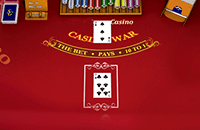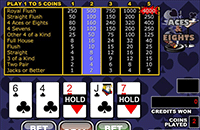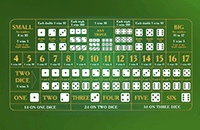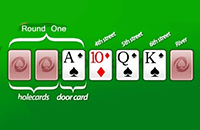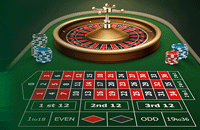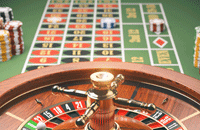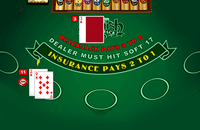Texas Holdem Poker – Rules Strategy & Tips
When I play Texas Hold’em poker I feel like James Bond in one of his movies. It’s no coincidence that this is my favorite game; any person of reasonable intelligence can become a good player through training. Psychology plays a major factor in this game. You can have a great hand but when someone puts all his chips on the table in a ‘no-limit” game, you always have a hard choice to make. Lucky for us there are “limit” tournaments to practice. I also recommend using software to find the fish (bad players). I have a great strategy for you, if you use a little common sense you can become a very good player and make a lot of money.
How To Play Texas Holdem
Learning how to play Texas Holdem takes study, practice, and persistence to become a world-class player.
It is a poker game that uses community cards. These are cards that can be used by all players at the table to make the best possible 5 card hand.
There are other forms of poker that you can play online, such as Omaha, 3 card Poker, 5 card draw, 7 card stud and Omaha Hi-Lo, but by far and away though the most popular game is Texas Hold’em.
Some online poker tournaments can have prize pools of hundreds of thousands or even millions. This sees a large number of people enter for the same buy-in and start with the same number of chips.
The last player remaining wins the tournament and the largest prize, with around 10% of the total entrants normally getting paid some amount.
You can also play in smaller tournaments with the same aim to be the last remaining player. These sit and go tournaments normally have just 1 table as opposed to bigger tournaments that can have hundreds running at the same time.
You can also play on cash tables which allow you to take your own money to the table, the main difference between the three is that in tournaments you only win money at the end of the tournament whereas with cash games the money you play with is yours and you can walk away with your winnings any time you want.
Texas Hold’em Rules
- A single deck of 52 cards is used in Texas Hold’em poker. All cards count as its respective value, although Aces can be high or low.
- One player is designated as the dealer, this will be shown online by a small disc and is moved around the table after each hand. Obviously online this person does not physically deal the game, it is simply to show where the first cards are dealt from.
- The player to the dealer’s left makes a bet known as the “small blind”. In a cash game, this bet will be the same each hand depending on the type of table you are sitting at. In a tournament, the blind bets raise at equal intervals, normally 8 or 10 minutes. The player to the left of the small blind – so 2 seats to the left of the dealer – makes a bet known as the “big blind”. These bets are compulsory and are designed to ensure there is money to be won in every hand and to ensure players can’t just sit waiting for one of the best starting hands to be dealt whilst not risking any money.
- Two cards are now dealt to each player face down, starting to the player on the dealers left, the small blind.
- As the first 2 players to the left of the dealer have already placed a bet before the cards we’re dealt, the player to the left of the big blind – 3 to the left of the dealer – gets to play first. They can either call the big blind bet (place a bet equal to it), Raise (place a bet that is more than the big blind), or Fold (not put a bet in and end their participation in the hand). The play then continues around the table in the same direction until all players have either Folded or Called the highest bet. If the play goes back round to the big blind and no one has raised, the big blind player can Check (effectively Call the largest bet but not put any funds in as their bet is already equal to the highest bet).
- Once the first betting round is finished, 3 cards are dealt in the middle of the table. These are Community cards (cards that can be used by any player) and is known most commonly as the Flop. These are dealt face up so all players can see them.
- Another round of betting now takes place, starting with the player to the dealers left (the player in the small blind position). If this player folded in the first round of betting, it will be the next player who starts the betting and so on until all players who are still in the hand have either Folded or placed a bet the same as all other players. As there is no forced bet in this round, all players can Check if they wish which means no further bets are made, although if one player does decide to bet, all other players will need to either match this bet by Calling or Fold.
- A community card is now dealt face up, this is known as the turn and means all players now have 6 cards they can use, their own 2 that only they can see and the 4 community cards that any player can see and use. This card is known as the Turn.
- Another round of betting now takes place following the same procedure as after the Flop. There are rules on some tables as to the minimum amount that can be bet at this point, this is normally double the minimum of the last 2 rounds, so double the big blind.
- Once this round of betting has finished, a 5th and final community card are dealt. This is known as the River and means players now have the 7 cards available to them in order to make the best possible 5 card hand.
- A final round of betting now takes place, the same format as after the Turn.
- Once this betting round has been completed, the first player remaining in the hand to the left of the dealer will show their cards. It will then continue around the table with each player showing their hand to determine who wins. Please note that whereas the first player to show needs to do so if the next player cannot match that hand, they can Muck their hand which means they agree they have lost but don’t show the other players what they had. If their hand is better, they need to show their hand to this effect. The hand needs to be made up of 5 of the 7 cards available, a player can use all 5 community cards, 1 of his/her own cards and 4 of the community cards, or both of his/her own cards and 3 of the community cards. The player with the highest-ranking hand wins the pot.
Texas Holdem Strategy
When playing Texas Holdem poker your best friends are patience and a detailed understanding of Texas Holdem Strategy. The best players flop 80% of the time in a 10 player game. The dealer is the best spot you can have whilst the small blind spot is the worst. This means when you are in the dealer position, you can play looser to see the flop and in the small blind position, you have to play tight. The closer you are to the dealer’s right side the better because you can see the actions taken by other players.
Best Texas Holdem Hands
The first two cards (your starting hand) that are dealt to you are the most important. If you are new to Texas Holdem I suggest you only play the following hands until you have more experience. Here are the best Texas Holdem Hands to start with.
| Ace-Ace when you have a double ace as a starting hand you need to raise, call a raise or re-raise. This is the best starting hand you can get. | |
| King-King The double king is the second best starting hand. Your strategy should be to raise, call a raise or re-raise depending on your table position, the risk you’re willing to take and the strength of your opponents. You need to study your opponents; are they loose? Is the one that just raised a good player or a bad? You need to get the edge, and the edges you get by knowing your opponents better than they know themselves. | |
| Queen-Queen The double queen is the third best starting hand. Your strategy should be to raise or call a raise depending on your table position, the risk you’re willing to take and the strength of your opponents. I wouldn’t re-raise with this hand, be a bit more careful with this hand. | |
| Jack-Jack The double jack is a good hand but you should play more careful here. Your strategy should be to call the big blind or to call one small raise. If a big raise is done by a fish you could take your chances. | |
| Ace-King Suited The ace-king suited hand is a good starting hand but you still need to wait for the flop before you start betting big. Your strategy should be to call the big blind or to call one small raise. | |
| Ace-Queen Suited Same strategy as the ace king suited. | |
| King-Queen Suited Same strategy as the ace queen suited. | |
| Ace-Jack Suited Your strategy should be to call or call one small raise against a loose player and wait for the flop. | |
| King-Jack Suited Your strategy should be to call or call one small raise against a loose player and wait for the flop. | |
| Queen-Jack Suited Your strategy should be to call or call one small raise against a loose player and wait for the flop. | |
| Ten-Ten Your strategy should be to call or call one small raise against a loose player and wait for the flop. | |
| Nine-Nine Your strategy should be to call or call one small raise against a loose player and wait for the flop. Your following move depends on the flop. If you get a bad hand after the flop, folding is usually a wise decision. Sometimes you can still get a nice hand with the turn and the river; you will get a better feel at this as you get more experienced. I suggest you play tournaments at first. |
Unsuited High Cards
Sometimes you will get unsuited high cards like this:
King TenYou can have other variations like a king with a ten or an ace with a queen. If you get cards like this don’t fold, you should wait for the flop, you should fold only if someone makes a raise. Again I have to say as you get more experienced you will get a better feeling for this. This is why I never recommend poker calculators, the only thing poker calculators do is turn you into a poker bot. You will never develop your own game like this. |
Starting Hand Probability
The odds of obtaining good cards with your starting hand in Texas Holdem.
| A | K | Q | J | 10 | 9 | 8 | 7 | 6 | 5 | 4 | 3 | 2 | |
|---|---|---|---|---|---|---|---|---|---|---|---|---|---|
| A | 85% | 68% | 67% | 66% | 66% | 64% | 63% | 63% | 62% | 62% | 61% | 60% | 59% |
| K | 66% | 83% | 64% | 64% | 63% | 61% | 60% | 59% | 58% | 58% | 57% | 56% | 55% |
| Q | 65% | 62% | 80% | 61% | 61% | 59% | 58% | 56% | 55% | 55% | 54% | 53% | 52% |
| J | 65% | 62% | 59% | 78% | 59% | 57% | 56% | 54% | 53% | 52% | 51% | 50% | 50% |
| 10 | 64% | 61% | 59% | 57% | 75% | 56% | 54% | 53% | 51% | 49% | 49% | 48% | 47% |
| 9 | 62% | 59% | 57% | 55% | 53% | 72% | 53% | 51% | 50% | 48% | 46% | 46% | 45% |
| 8 | 61% | 58% | 55% | 53% | 52% | 50% | 69% | 50% | 49% | 47% | 45% | 43% | 43% |
| 7 | 60% | 57% | 54% | 52% | 50% | 48% | 47% | 67% | 48% | 46% | 45% | 43% | 41% |
| 6 | 59% | 56% | 53% | 50% | 48% | 47% | 46% | 45% | 64% | 46% | 44% | 42% | 40% |
| 5 | 60% | 55% | 52% | 49% | 47% | 45% | 44% | 43% | 43% | 61% | 44% | 43% | 41% |
| 4 | 59% | 54% | 51% | 48% | 46% | 43% | 42% | 41% | 41% | 41% | 58% | 42% | 40% |
| 3 | 58% | 54% | 50% | 48% | 45% | 43% | 40% | 39% | 39% | 39% | 38% | 55% | 39% |
| 2 | 57% | 53% | 49% | 47% | 44% | 42% | 40% | 37% | 37% | 37% | 36% | 35% | 51% |
Post Flop Strategy
Although it is the same game, and the same hand, the strategy you play pre-flop and post-flop can often be totally different.
Before the Flop, you only have your 2 Hole cards to consider, just 2 of the 7 cards that will be available to you come the end of the hand.
After the Flop, you will know 5 of the 7 cards and will have a much better idea of whether you are likely to win the hand on a Showdown or whether you need to try and bet other players off the pot.
The real money is made after the Flop too since there are still 3 of the 4 betting rounds left to play. Therefore, although the pre Flop strategy is important, it is the Post Flop strategy that could potentially either make you a lot of money or see you lose a lot.
Playing the odds, bluffing your hand, picking up on any tells from your opponents, and mixing up your game are just a few of the strategies to consider at this point.
Post Flop play is, therefore, more advanced and involved than a pre Flop strategy.
Reading Your Opponents
Whether you’ve called, raised, or checked your way pre Flop, the first thing you need to think about after the Flop is your opponents and how they react. This is harder to do in an online game as you cannot physically see your opponents, but it is still worth making notes on players if the facility is available as these can help you in future hands when you are up against the same player.
An example would be if a player is aggressive pre Flop and continues betting, only to lose a Showdown with a weak hand. Make a note of this as in a future hand he or she may well try the same trick again, having this information available to you can help.
You also need to remember who did what before the Flop. If someone Raised but then Checked the Flop, they could have missed, or hit a good hand and are changing their tactics to slow play, hoping others will put more chips in. Equally, if there was no action and the Big Blind simply Checked, beware if they bet on a low board after the Flop as you have no real idea what they may hold.
Proceeding After a Pre-Flop Raise
One of the most common and discussed techniques in post Flop Texas Holdem strategy is the follow-through bet. This comes into play if you Raise before the Flop and are either first to act or the action gets checked to you. Many people would argue that almost every time you are in that position you should follow through with an attempt to take the hand down, irrespective of whether you have hit a hand or not.
The downside to this is that it has become so common that you rarely see players Fold to it anymore, and instead use it as a way to Bluff by Checking and then Raising any bet. There will also be a place in poker for this kind of technique, but try and gauge your opponents and their characteristics as much as possible before you try it when missing the Flop.
If you Raised pre Flop and hit a good hand, you will need to consider the possibilities that are on the board.
If there are 2 or 3 of the same suit and therefore the possibility of a player hitting a Flush later in the hand, it may be worth trying to take down the pot on the Flop with a larger bet rather than allowing a player to see the Turn and River on the cheap.
If you hit a monster such as a Full House, you may consider letting other players do the betting in the hope that they do hit their Flush or Straight giving them the confidence to bet big.
You will also need to consider that even though you may have hit a good hand, another player may also have hit, such as you holding AK on a board showing A J 3 of different suits. In this case, you are well set but anyone that called a pre Flop Raise with AJ or 33 will be doing better and you could be in for a big loss if you are not careful.
It is worth varying your strategies, for this reason, as if players are making notes on you just as you are on them, they may think they have got you sussed. A variation of big pocket pairs or suited connectors, for example, can confuse your opponent and allow you to take advantage of their uncertainty.
Proceeding After a Pre – Flop Call or Check
If you entered the pot pre Flop in late position and have a less thank premium starting hand, the strategy post Flop is less complicated. Players won’t be expecting you to have much compared to those in an early position that is still in the hand, and therefore won’t be looking to you to lead.
It is, therefore, possible to make a decision simply on whether or not you hit the Flop. If you made a hand, you can decide whether to come out all guns blazing and put a bet in or slow play waiting to see what others do. However, slow playing with anything less than a Full House can often lead to disaster if a player hits a Flush or Straight on the Turn or River. Giving them a cheap option to view these cards can often lead to them hitting their hand which will put them ahead of yours.
If there is nothing but Checking going on you have the opportunity to steal the pot with a relatively small bet, nice if you haven’t hit and there are still a few players in the hand.
Maybe the best part of playing after the Flop when in late position is that it gives you the chance to sneak up on the remaining players if you do hit your hand. Calling pre Flop with suited connectors, for example, gives you the chance of a Flush, Straight, or even Three of a Kind if the Flop shows a pair of one of your numbers. It is hard for the other players to read what you have and puts you in a position to either bet or Check-Raise and could lead to you getting chips from someone who has a high pocket pair and who believes you could be Bluffing.
When Obtaining a Full House
Don’t hesitate, don’t fear, the chances of you losing are very slim. When I see a full house like this after the flop in a no-limit game, I don’t just put all my chips on the table right away. I bet a high amount first, after the turn I bet an even higher amount and when the river comes I put all my chips on the table. I do this to make more money from my opponents because if you put all your chips on the table after the flop chances are all of them will fold. When playing a limit game you should start making raises. Some players play with a betting strategy such as Oscars Grind or the Oscars Grind-The Positive Grind, but I usually stay clear of these.
Playing the Turn and River
By the time you reach the Turn and River, there are likely to be only 2 or 3 players left in the hand. Whilst this does mean you have less to think about with regards to what your opponents hold, the rising amount of chips in the pot mean that a mistake at this point could prove costly.
Considering the bet size and pot odds are important throughout the hand, it is most important at the later stage. If you have a draw after the Flop, for example, a call would be easier to make when there are 2 cards left, however, if you miss the Turn and therefore only have 1 card left to play, you have to consider the risk of another player puts a bet in. If they only bet a small amount into a relatively large pot, it is easy enough to call, but with a large bet, you need to decide whether it is worth the risk with only 1 more card to come in order to complete your hand.
On the flip side, if you feel you are ahead, consider a large enough bet so that other players Fold as opposed to letting them see the River card cheaply and giving them a chance to hit their hand. Position and pressure are 2 of the most important aspects at the tail end of a hand as with fewer players involved acting first and forcing the play can give you a big advantage, even more so than at the start.
At the end of the day, these decisions get easier with experience so play as much as you can whilst learning.
If possible, you should play low-value tournaments as opposed to free play or free-rolls as you will often find these games become more like a lottery with people betting a lot more than they otherwise would if they use their own money.
Texas Holdem Tips
To summarise, here are some Texas Holdem Tips:
- Do not play with fear, your opponents can smell it
- Play with good money management and don’t bet all your money on a weak hand.
- Learn to bluff, but don’t bluff with garbage
- Learn how your opponents play, are they loose or tight? Do they bluff a lot?
- Enter tournaments, it’s a cheaper and much better way of improving your game.
Texas Holdem Terms
When first learning the game you will come across these Texas Holdem Terms:
- Muck Hand: When a player agrees they have lost, but doesn’t show the other players what they had.
- Small Blind: When the player to the dealer’s left makes a bit. This is known as a small blind
- Big Blind: The player to the left of the “small blind” – so when a player 2 seats to the left of the dealer makes a bet, this is known as the “big blind”.
- The Flop: These are Community cards dealt face up by the dealer (cards that can be used by any player) and is known most commonly as the Flop.
- The Turn: The 4th card of the community cards dealt is know as “The Turn”.
- The River: The 5th and final community card dealt is known as “The River”.
- All-In When a player commits all their chips to the active pot, they are “All-In” and cannot bet any further chips as they have none available to them.
- Ante A ‘forced’ pre-flop bet which is made by all players for an equal amount, normally 10% of the value of the Big Blind. This often occurs in the latter stages of a tournament to ensure it completes in a timely fashion and it increases the same time the Blinds increase.
For a complete list of Poker Terms you can visit our Poker Terms & Glossarypage.
Related Articles :
Top Poker Sites
Best Online Poker Hands
Poker Video Tutorials

